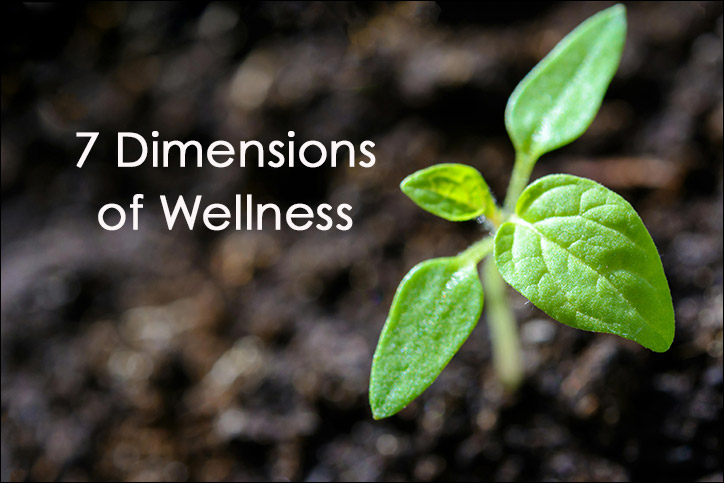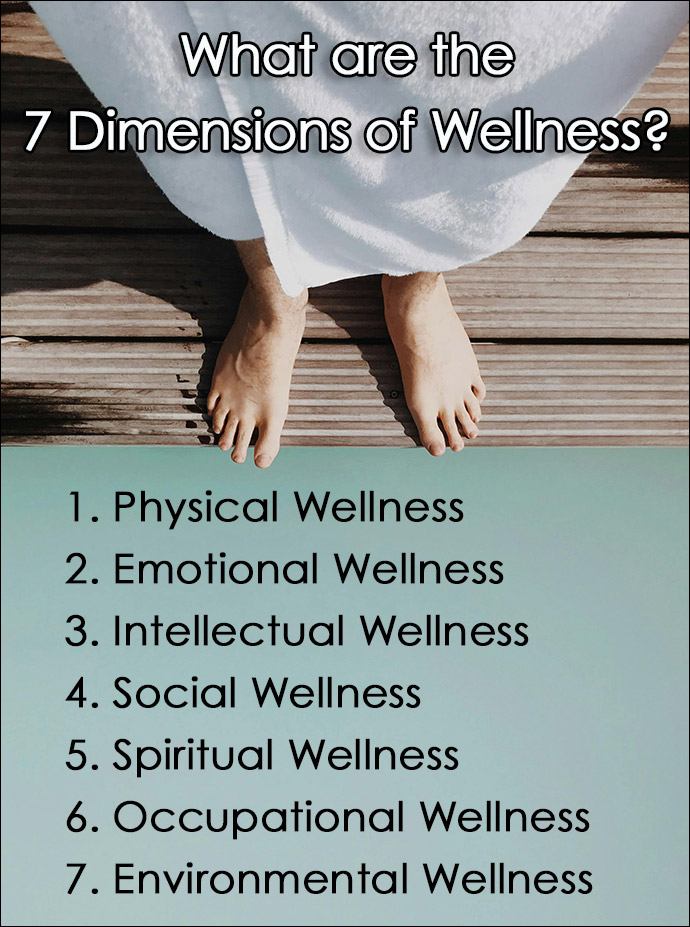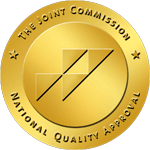Table of Contents
The 7 Dimensions of Wellness are mutually connected aspects of life that play a significant role in our health, happiness, and overall wellbeing.
Because each of the seven areas of wellness are connected to the others, improving one has a positive effect on the others.
Developing and enhancing the 7 dimensions of wellness leads to better physical and mental health, quality of life, and reinforces addiction recovery.
To get started, it’s necessary to have a better understanding of what wellness means, each of the dimensions, and ways to improve them.
What is Wellness?
Dictionary.com defines wellness as, “the quality or state of being healthy in body and mind, especially as the result of deliberate effort.”
Wellness is more than simply being physically healthy. It is a holistic journey of optimizing the mind, body, and spirit to improve overall quality of life.
By nurturing all aspects of our being – physical, mental, emotional, and social – we achieve a balance and harmony that leads to a happier and more fulfilling life.
Reaching a healthy state of wellness is similar to learning how to achieve self actualization.
Halbert L. Dunn is considered the father of the wellness movement, with the roots beginning with his published his book, “High-Level Wellness,” in 1961.
Dunn’s high-level wellness model describes wellness as more than the absence of illness or disease. It offers a holistic view that integrates the body, mind, and spirit into multiple dimensions of wellness.
He considered the concept of wellness to be a journey of actively pursuing better health and wellbeing instead of simply treating illness.
His work had a huge influence on the way we view health and wellness today.
What are the 7 Dimensions of Wellness?
The 7 dimensions of wellness are all connected and dependent on each other, so improving one dimension can have a positive effect on the others. They include:
- Physical Wellness
- Emotional Wellness
- Intellectual Wellness
- Social Wellness
- Spiritual Wellness
- Occupational or Vocational Wellness
- Environmental Wellness
Description of the 7 Dimensions of Wellness
1. Physical Wellness
Physical wellness is associated with maintaining the body by exercising, eating nutritious food, getting proper sleep, and making healthy lifestyle choices. Good, physical health increases energy, boosts immunity, and minimizes illness.
Ways to improve physical wellness:
- Exercise regularly for at least 30 minutes a day, 4 or 5 days a week
- Eat a balanced diet of fruits, vegetables, lean proteins, and whole grains
- Get 7 to 8 hours of quality sleep each night
- Drink 8 or more glasses of water each day
- Abstain or limit alcohol
- Avoid tobacco and nicotine
- Reduce or moderate caffeine intake
- Have annual health screenings
- Minimize sugar intake
2. Emotional Wellness
Emotional wellness is necessary for effectively managing feelings and emotions in a healthy way. When emotional wellness is high, we can positively manage stress and challenging situations.
Ways to improve emotional wellness:
- Practice meditation, mindfulness, or breathwork
- Learn to identify and reduce stress levels
- Keep a gratitude jar or gratitude journal
- Perform acts of kindness
- Socialize with family and friends
- Do things that are enjoyable
3. Intellectual Wellness
Intellectual wellness entails having a sense of curiosity, learning new skills, expanding your knowledge about different subjects, and being creative.
Ways to improve Intellectual Wellness
- Attend classes or workshops
- Read books or educational magazines
- Watch documentaries
- Travel to new places
- Play games and puzzles
- Adopt a new hobby
- Have mock debates with friends
- Spend time at cultural events
- Get tickets to the theater
4. Social Wellness
Social wellness involves cultivating healthy relationships and positively interacting with other people. It builds interpersonal communication skills and instills a sense of belonging and connection with others.
Ways to improve Social Wellness
- Spend quality time with family
- Volunteer to help others
- Participate in community events
- Join a club to meet new people
- Have lunch or dinner regularly with friends
- Practice listening skills
- Take your dog to the dog park to be with other dog owners
5. Spiritual Wellness
Spiritual wellness is concerned with finding a sense of meaning and purpose in life. This can be explored through religion, meditation, nature, or connecting with others.
The goal is to improve personal values and develop an inner peace through spiritual wellness activities.
Ways to improve Spiritual Wellness:
- Practice meditation or mindfulness
- Study spiritual or philosophical teachings
- Attend church or religious services
- Spend time outside in nature
- Engage in activities that boost your sense of purpose
- Start a gratitude journal
6. Occupational or Vocational Wellness
Occupational or vocational wellness is linked to job satisfaction and fulfillment with your career or occupation. This is associated with pursuing or maintaining a career that you find interesting, meaningful, and offers a healthy work-life balance.
There’s a saying, “if you enjoy what you do, you will never work a day in your life.”
Ways to improve Occupational Wellness
- Choose a career you are passionate about
- Nurture positive relationships with co-workers
- Set goals for upward growth
- Cultivate a positive work-life balance
- If you are unhappy with your current career, find a different one
7. Environmental Wellness
Environmental wellness means connecting with your local area, surroundings, and community in a way that has a positive impact. This can include interacting with your home, school, work, neighborhood, or nature.
Ways to improve Environmental Wellness
- Spend time outside in nature
- Conserve water and energy
- Recycle and reduce waste
- Use products that are safe for the environment
- Eat local and support nearby businesses
- Practice sustainable activities
- Volunteer and encourage environmental causes
Strengthening the 7 Dimensions of Wellness
Setting a goal of improving each area of health individually will strengthen all 7 dimensions of wellness because they are interconnected.
Improving wellness is a continuous work in progress that begins with small, positive steps that eventually add up to the larger reward of balance and harmony in mind, body, and spirit.
Create a plan to focus on each of the seven dimensions and set achievable goals that are within reach.
Be patient and flexible on the wellness journey and track your progress as you go. Many people find success pursuing the goals through support from family and friends, so there’s no reason to go it alone.
Strengthening the 7 dimensions of wellness leads to improvements in overall health, happiness, and the way we feel each day.
Frequently Asked Questions
How do the 7 dimensions of wellness affect mental health?
The 7 dimensions of wellness each affect mental health individually and play an even larger role when combined together for overall wellness. Some of them overlap with each other because they are all interconnected.
The mind-body connection of physical wellness through exercise increases blood circulation to fuel the brain and enhances neurotransmitter activity to boost mood. Exercise combined with healthy nutrition and proper sleep all help to reduce stress, anxiety, and depression.
Emotional wellness develops self-awareness and coping skills for managing emotions.
Intellectual wellness cognitively stimulates the mind and raises self-esteem.
Social wellness promotes relationships, belonging, and helps avoid loneliness and isolation to stave off depression.
Spiritual wellness instills a sense of purpose, meaning, and peace to lessen anxiety, stress, and functional depression.
Occupational or vocational wellness reinforces work and career satisfaction that heightens self-esteem and self-worth.
Environmental wellness improves mental health by connecting harmoniously to nature and the world around us.
Do the 7 dimensions of wellness impact addiction and recovery?
Yes, the 7 dimensions of wellness can have a positive impact on recovery or a negative effect on addiction when wellness is lacking.
Negative Effect on Addiction
When emotional wellness is low, it can cause a person to use drugs or alcohol to cope with stress and depression.
Low social wellness can lead to isolation, loneliness, and relationship issues that fuel addiction.
Stress or financial problems associated with poor occupational wellness can either be caused by the destructive nature of addiction or be the reason why people use alcohol or drugs.
Weak environmental wellness associated with a toxic home environment can stimulate substance use and addiction or lead to relapse and make it difficult to remain sober.
Positive Impact on Addiction Recovery
Improving the 7 dimensions of wellness, or even some of the dimensions, will have a healthy effect on recovery and help avoid relapse.
Physical wellness heals the body during recovery to improve mood and the way a person feels physically.
Emotional wellness develops coping skills for effectively managing stress, depression, and emotions.
Social wellness is necessary for building or repairing relationships and relying on social support that is crucial for sobriety and recovery.
Spiritual wellness focuses on spirituality and a higher power to create a sense of purpose, meaning, and inner peace.
Occupational wellness offers a daily sense of purpose and meaning from a healthy work environment.
Environmental wellness in a supportive home reduces the risk of relapse and promotes long-term sobriety.
Which of the 7 dimensions of wellness is the most important for addiction recovery?
It’s difficult to choose the best dimension of wellness because they are all important for addiction recovery.
With that said, emotional wellness will have a profound impact on recovery and preventing relapse.
Many people begin using drugs and alcohol to cope with negative thoughts and emotions related to stress, anxiety, depression, and other mental health issues.
If unhealthy thoughts and behaviors are not addressed during addiction treatment, recovery may not be successful, and it could lead to relapse.
Addiction treatment often uses cognitive behavioral therapy and similar approaches aimed at identifying and coping with negative thoughts and behaviors.
Many of these therapies serve as the foundation for recovery by developing skills to improve emotional wellness.
While the other wellness dimensions are necessary for recovery, promoting emotional wellness will probably have the biggest impact on overcoming addiction.
Why are the 7 dimensions of wellness sometimes listed as 6, 8, or 9 dimensions?
There are a number of different wellness models in use today. The seven dimensions of wellness is commonly used, although other models list six, eight, nine, or more dimensions.
The original 6 dimensions of wellness model was created by Dr. Bill Hettler in 1976 at the National Wellness Institute. It included the following six dimensions:
- Physical
- Emotional
- Intellectual
- Spiritual
- Social
- Occupational
Later, the environmental wellness dimension was added, followed by financial wellness and cultural wellness, for a total of nine dimensions.
It’s important to understand that all of the wellness dimension models serve the same goals and purpose of improving and nurturing overall health and wellbeing.





